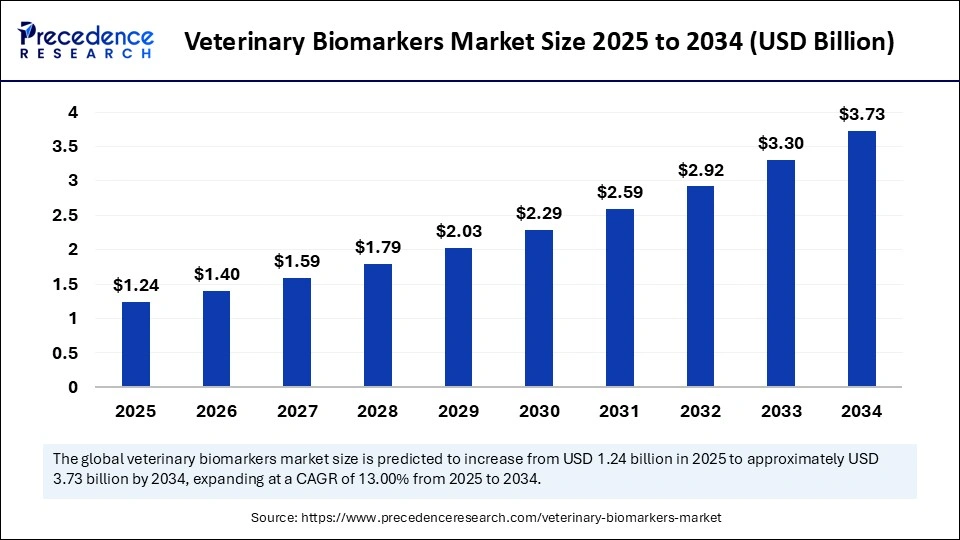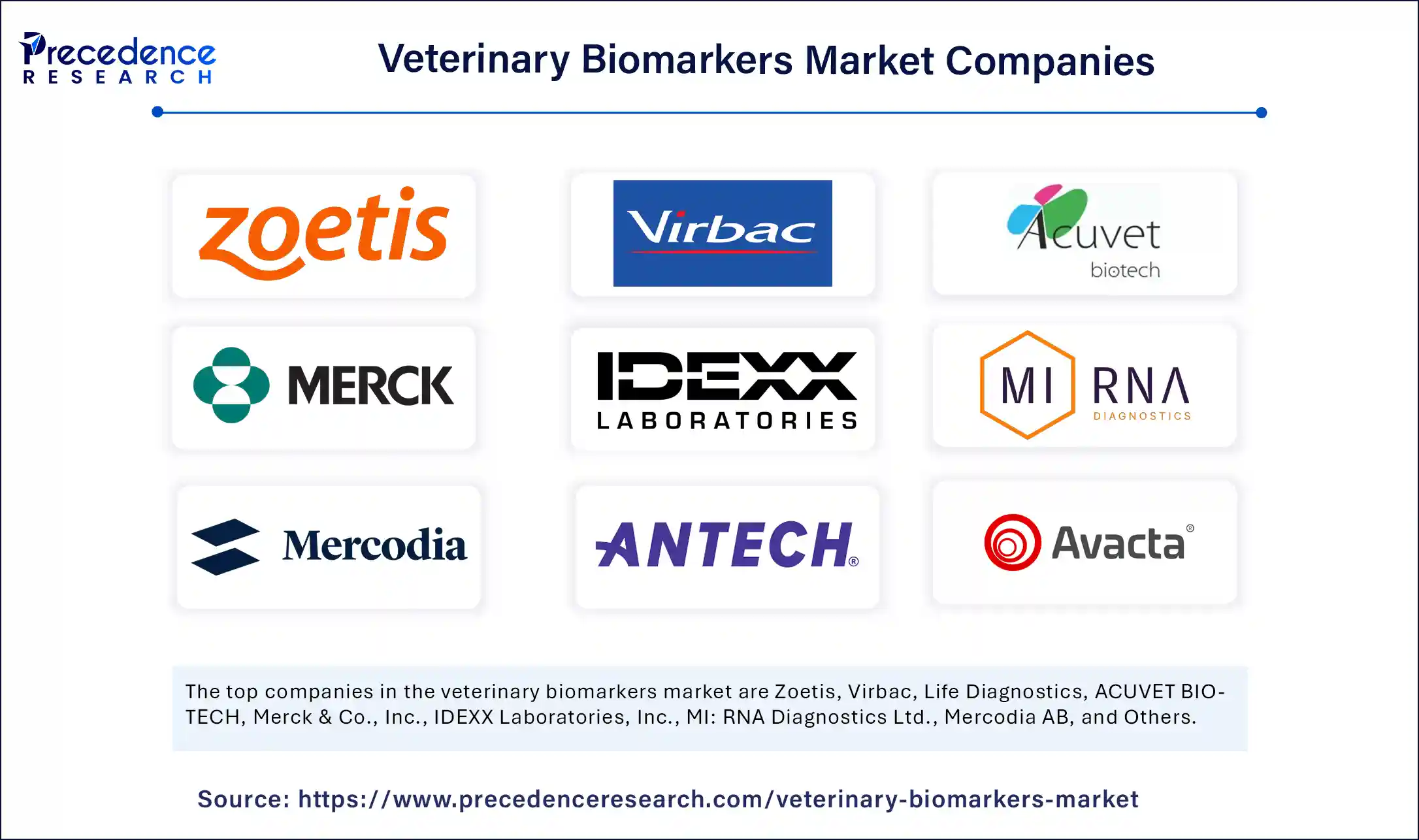
Veterinary Biomarkers Market Key Points
- In 2024, North America emerged as the dominant region in the global market, accounting for the largest share of 41%. Meanwhile, the Asia Pacific region is forecasted to register a strong CAGR of 14.5% throughout the projected period.
- By animal type, companion animals held the highest market share in 2024, whereas the production animals segment is poised for notable growth in the coming years.
- In terms of product, the biomarkers, kits & reagents segment was the market leader in 2024, while the biomarker readers segment is anticipated to grow at the fastest pace moving forward.
- By application, disease diagnostics led the market in 2024, and the preclinical research segment is expected to expand rapidly during the forecast period.
- Based on disease type, inflammatory and infectious diseases accounted for the largest share of 40% in 2024, while the cardiovascular diseases segment is projected to see significant growth ahead.
Market Overview
The Veterinary Biomarkers Market represents a rapidly growing and increasingly important segment within the animal healthcare industry. Biomarkers—biological molecules found in blood, other body fluids, or tissues—play a critical role in diagnosing, monitoring, and predicting disease in both humans and animals. In the veterinary space, biomarkers are used to detect early signs of disease, assess treatment efficacy, and provide insights into animal physiology, nutrition, and stress levels. This market encompasses companion animals (dogs, cats), livestock (cattle, poultry, swine), and equine species, with applications ranging from infectious disease diagnostics to oncology, cardiology, and metabolic disorders.
As awareness around animal health, zoonotic diseases, and food safety continues to grow, veterinary practitioners, pet owners, and livestock producers are placing greater emphasis on early detection and preventive care. Veterinary biomarkers help reduce disease progression, lower treatment costs, and enhance animal welfare and productivity. The market is witnessing innovation in diagnostic kits, lab-based assays, and point-of-care solutions, driven by growing veterinary diagnostics infrastructure, rising animal healthcare expenditure, and the increasing availability of advanced biosciences technologies adapted from human medicine.
Growth Factors
Several key factors are driving the growth of the veterinary biomarkers market. One of the primary growth engines is the increasing pet ownership and humanization of animals, especially in North America, Europe, and parts of Asia. Pet parents are now more proactive about routine health screenings and personalized care, mirroring human healthcare trends and spurring demand for diagnostics that include biomarker analysis.
Another major factor is the intensification of livestock production in developing countries, where herd health is critical to ensuring productivity and food security. Veterinary biomarkers help farmers and veterinarians detect diseases early, monitor herd health efficiently, and ensure safe meat and dairy supply chains. With the global push for antibiotic stewardship and responsible farming practices, biomarker testing is becoming essential for informed therapeutic decisions.
Additionally, advancements in veterinary diagnostics technologies—including immunoassays, PCR-based techniques, and mass spectrometry—are enabling the identification of more specific and sensitive biomarkers. Combined with rising R&D investments from animal health companies and research institutions, these developments are expanding the clinical use cases for veterinary biomarkers across both acute and chronic diseases.
Impact of AI on the Veterinary Biomarkers Market
Artificial Intelligence (AI) is increasingly transforming the veterinary biomarkers landscape by improving diagnostic accuracy, predictive analytics, and clinical decision support. AI-powered algorithms are capable of analyzing large volumes of data from biomarker assays, clinical records, and wearable monitoring devices, leading to earlier and more precise detection of disease in animals.
One of the most impactful AI applications is in pattern recognition and anomaly detection, where machine learning tools analyze trends in biomarker levels over time to identify subtle changes that may indicate emerging health issues. This is particularly valuable in herd health management, where AI can help predict outbreaks or detect subclinical diseases before symptoms appear.
In companion animal care, AI enables personalized health tracking through integrated platforms that combine biomarker data with behavioral and biometric inputs from smart collars or veterinary apps. These tools allow veterinarians and pet owners to receive real-time health alerts and treatment recommendations based on AI analysis.
AI is also aiding in biomarker discovery by accelerating the identification of novel targets through genomic, proteomic, and metabolomic data analysis. This speeds up the development of new diagnostics and expands the range of measurable indicators for complex diseases.
Moreover, AI enhances diagnostic interpretation by reducing false positives/negatives and standardizing readings across labs and clinics. This improves the reliability of biomarker-based testing and builds greater trust among veterinarians and producers.
Market Drivers
Key drivers influencing the veterinary biomarkers market include:
-
Rising incidence of chronic and infectious diseases in animals, including cancer, diabetes, renal disorders, and zoonoses.
-
Growing demand for early disease detection and preventive veterinary care, particularly among urban pet owners and commercial livestock operations.
-
Increased spending on companion animal healthcare, driven by greater awareness and emotional investment in pet wellness.
-
Expansion of veterinary diagnostic infrastructure, including point-of-care testing facilities and reference laboratories.
-
Regulatory support and global initiatives for antimicrobial resistance (AMR) monitoring, encouraging biomarker-based alternatives to empirical treatments.
Opportunities
There are several promising opportunities for innovation and growth in the veterinary biomarkers market:
-
Development of species-specific biomarkers for more accurate diagnostics in animals such as horses, poultry, and exotic pets.
-
Expansion of point-of-care biomarker tests, enabling faster decision-making in clinics, farms, and field settings.
-
Integration of biomarkers with digital health tools and wearable devices, creating holistic animal health monitoring ecosystems.
-
Biomarker-based precision nutrition and stress management for livestock, supporting animal welfare and sustainable farming.
-
Collaborations between veterinary and human health sectors, facilitating cross-species insights and technology transfer (One Health approach).
Challenges
Despite strong market potential, the veterinary biomarkers market faces several challenges:
-
Limited standardization and validation of biomarkers across species, leading to variability in diagnostic outcomes.
-
High cost of development and testing, particularly for novel biomarker discovery and commercialization.
-
Shortage of skilled professionals and lab capabilities, especially in emerging markets, to conduct and interpret biomarker assays.
-
Regulatory complexities and lack of harmonized global guidelines, which can slow product approval and adoption.
-
Lower awareness among livestock producers and small animal clinics about the benefits and applications of biomarker testing.
Market Scope
| Report Coverage | Details |
| Market Size by 2034 | USD 3.73 Billion |
| Market Size in 2025 | USD 1.24 Billion |
| Market Size in 2024 | USD 1.10 Billion |
| Market Growth Rate from 2025 to 2034 | CAGR of 13.00% |
| Dominating Region | North America |
| Fastest Growing Region | Asia Pacific |
| Base Year | 2024 |
| Forecast Period | 2025 to 2034 |
| Segments Covered | Animal Type, Product Type, Application, Disease Type and Region |
| Regions Covered | North America, Europe, Asia-Pacific, Latin America, and Middle East & Africa |
Regional Outlook
North America leads the veterinary biomarkers market due to its advanced veterinary care infrastructure, high pet ownership rates, and the strong presence of major animal health companies. The U.S. continues to see increased demand for biomarker-based diagnostics, especially in cancer and renal disease detection in dogs and cats.
Europe also holds a significant market share, with countries like Germany, France, and the UK adopting biomarker-based diagnostics in both pet and livestock healthcare. The region benefits from well-regulated veterinary practices and strong collaboration between academia and industry in animal research.
Asia-Pacific is expected to register the fastest growth in the coming years, fueled by rising income levels, increased pet adoption, and the modernization of livestock management practices. China, India, Japan, and Australia are investing in veterinary diagnostics and bioinformatics, making the region a hotbed for biomarker innovation.
Latin America, Middle East, and Africa are gradually expanding their veterinary diagnostics markets. While infrastructure limitations exist, international aid programs, growing meat exports, and rising awareness of zoonotic diseases are encouraging the adoption of biomarker testing in these regions, particularly in large-scale farming operations
Veterinary Biomarkers Market Companies

- Zoetis
- Virbac
- Life Diagnostics
- ACUVET BIOTECH
- Merck & Co., Inc.
- IDEXX Laboratories, Inc.
- MI: RNA Diagnostics Ltd.
- Mercodia AB
- Antech Diagnostics, Inc.
- Avacta Animal Health Limited
Segments Covered in the Report
By Animal Type
- Companion Animals
- Dogs
- Cats
- Others
- Production Animals
- Cows
- Pigs
- Others
By Product Type
- Biomarkers, Kits & Reagents
- Biomarker Readers
By Application
- Disease Diagnostics
- Preclinical Research
- Others
By Disease Type
- Inflammatory & Infectious Diseases
- Cardiovascular Diseases
- Skeletal Muscle Diseases
- Tumor
- Others
By Region
- North America
- Europe
- Asia Pacific
- Latin America
- MEA
Also Read : Medicated Skincare Market
Get this report to explore global market size, share, CAGR, and trends, featuring detailed segmental analysis and an insightful competitive landscape overview @ https://www.precedenceresearch.com/sample/6080
You can place an order or ask any questions, please feel free to contact at sales@precedenceresearch.com|+1 804 441 9344
- Arteriovenous Implants Market Enhance dialysis outcomes with advanced grafts, endovascular access, and AI-assisted precision - September 16, 2025
- Smart Retinal Implants Market Restore vision with wireless bioelectronic prosthetics and AI-powered retinal technologies - September 16, 2025
- Myopia Treatment Devices Market Size to Reach USD 38.51 Billion by 2034, Growing at a CAGR of 7.86% - September 1, 2025
